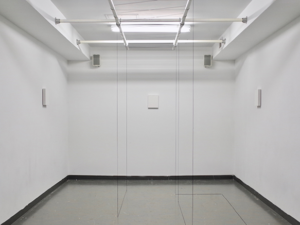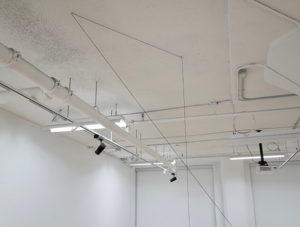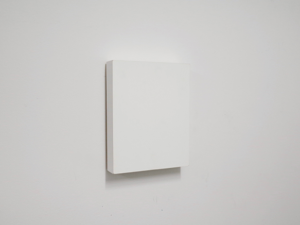Abstract | PDF | UnDisciplined (Feb 2020) | Request Permissions
Variable Frequencies: A Sound Installation Investigating Process and Interaction
Angus Tarnawsky
Biography | Notes
Keywords: Affect, Installation Art, Noise, Radio, Sound Studies
Introduction
Variable Frequencies builds on the technology of radio to explore sonic, social and political implications of transmission. Through a unification of physical and ephemeral states, fixed elements are encouraged to evolve into relational systems. Considering the ways in which sound installations can derive interactivity from participation, the project addresses the interdependent nature of ‘affect’ and ‘effect’ with reference to the specific framework defined by Gilles Deleuze and Félix Guattari.[1] In the preface to the English edition of the book A Thousand Plateaus, translator Brian Massumi clarifies that for Deleuze and Guattari, ‘affect’ broadly represents “an ability to affect and be affected.”[2] In the scope of my own practice, I rely on this definition and the successive work on the subject by Massumi, and other contemporary theorists like Jane Bennett, and Erin Manning, who consider affective relations—rather than purely emotive affection—as a way of understanding actions, beyond observable cause and effect.[3]
Sound and Space
Sound commands attention and rewards devotion. If considered in relation to time and space, foundational couplings emerge. For example, loud sounds might appear powerful in large or reverberant spaces, whereas soft sounds can achieve greater intimacy in smaller spaces. However since sounding (the making of sound) and listening are inherently relational processes, more complex scenarios tend to emerge. The combination of physical sites and material configurations—human or otherwise—play a great role in determining the eventual reception of sonic events. In any circumstance, listening, or simply being exposed to sounds for longer durations, can create altered modes of perception that encourage deeper engagement with the surrounding environment.
In her book Listening to Noise and Silence, artist and writer Salomé Voegelin proposes that “sound prompts a re-thinking of temporality and spatiality.”[4] In this context, she considers how “time and space extend each other and produce each other as immaterial composite.”[5] As a point of contrast, Voegelin notes that “vision captures, orders and disciplines space but it does not see the simultaneity of its time.”[6] From a sound installation perspective, if sound, vision, time, and space can impact listeners, in what way does the presence of a listener alter the surrounding environment? Rather than focusing on purely acoustic alterations, I am interested in how presence affects the context of sounds in spaces.
Philosopher Jacques Rancière addresses this concern through what he terms “the distribution of the sensible.”[7] In part, this concept can be defined as “a delimitation of spaces and times, of the visible and invisible, of speech and noise, that simultaneously determines the place and the stakes of politics as a form of experience.”[8] In this way, politics, social visibility, cultural context, and privilege are seen as inseparable elements. For Rancière, “artistic practices are ‘ways of doing and making’ that intervene in the general distribution of ways of doing and making as well as in the relationships they maintain to modes of being and forms of visibility.”[9] For my own practice, this leads to questions of where and how such politics of listening, sounding, and active engagement might intersect within contemporary gallery spaces.
Overview of the Installation
Variable Frequencies attempts to work harmoniously with a variety of sites to exploit the potential of sympathetic resonance and dissonance. Using extended lengths of copper wire, sculptural forms are constructed as architectural extensions of gallery spaces (Figures 1- 2). A custom-built radio transmitter is attached to each wire sculpture, allowing it to function as a radio antenna. Depending on the size of the room, the broadcast range of the structure is up to ten-metres. This transmission is received by a series of portable radios, positioned discreetly inside wall-mounted frames, and tuned into the broadcast frequency (Figure 3). Sonic compositions are then distributed spatially within the confines of the installation space.
In addition to utilizing physical space, the project also relies on unused broadcast space, existing between commercial FM stations. For example, the use of 90.2 FM where stations exist on 90.1 FM and 90.3 FM. When installing at a new site, finding vacant frequencies is often a challenge. Additionally, North American regulations limit broadcasting on commercial frequencies beyond a relatively small radius of approximately thirty[10] to sixty[11] metres. As a whole, these kind of constraints have proven to be positive, in that they encourage unique versions of Variable Frequencies to exist from one installation to the next.
Once the antenna and receivers are switched on, nearby bodies—knowing and unknowing participants—have the potential to alter the effectiveness of the transmission and reception. This process is made audible through bursts of noise and intermittent connections to commercial radio stations. On the one hand, the interference occurs since the radio transmitter—an influential DIY design by Japanese media artist Tetsuo Kogawa—is relatively unstable.[12] On the other hand, almost all analog radio receivers are highly sensitive to environmental factors. Aside from bodies, variables like nearby objects, time of day, location within a space, or the geography of the site, can all cause fluctuations in reception or transmission. In part, these reactive tendencies can be explained through capacitance. This term describes the means by which small amounts of electricity can be transferred between sources. Commonly occurring with direct electrical connections (physical contact with circuits), it can also exist wirelessly. For radio, either circumstance results in the inability of devices to accurately tune into or distribute broadcast sources.
While attempting to elicit control over radio waves, the multiplicity of affective actions and reactions constitutes what Deleuze and Guattari refer to as an ‘assemblage.’[13] That is to say, within the system, everything is relational. Affect mobilizes as a form of omnidirectional influence. Visible interventions and invisible mechanisms work together to encourage material engagement. Noise appears and disappears, defining change through constant emergence. Interstitial zones connect aware and unaware agents of change. Interference between signals is inevitable. Through all of this, observers become participants, and passive viewing or listening is guided towards immersion in time, space, and transmission.



Radio Politics and Broadcast Structures
Radio waves are a form of naturally occurring electromagnetic radiation, often observed by humans but not fully understood until the 19th century. Anthropologist Daniel Fisher describes radio as a “spatial metaphor.”[14] He sees transmission as a form of modernization, a technique for nation building, a resource for counter-hegemonic voices, and a platform for participatory democracy.[15] However, frequently harnessed for capital or political gain, the contemporary world is dictated and shaped by the invisible signals of broadcasting in vastly different ways. While many systems work so that the masses can receive signals—radio or otherwise—transmission itself remains a privilege. Newer forms of media distribution may challenge or provoke this hierarchy, but they are inevitably shaped to some extent by pre-existing systems and ideologies. Sound theorist Brandon LaBelle suggests that “transmission is equally about power and propaganda,” adding that “to transmit is to tap the political heart of social connection.”[16]
Broadcasting is one of the most important developments of the 20th century, enabling a massive change in the ability to communicate locally and globally. While the process of transmission is invisible, to this day much of the wider broadcast infrastructure is visible. Communication towers dominate landscapes, amplifying not only the reach of transmissions, but elevating the visual presence and importance of such actions. Inspired by this idea, the most prominent visible element within Variable Frequencies is the site-responsive radio antenna. Woven intricately within a space, it provides a point of engagement for viewing, listening, and interacting with the installation.
Expectations of Interaction and Participation
As part of a wide-reaching analysis of noise, economist Jacques Attali reflects that “more than colors and forms, it is sounds and their arrangements that fashion societies. With noise is born disorder and its opposite: the world.”[17] For Attali, noise generates boundaries and articulates spatial territories. In this sense, noise is a crucial transgression of interaction, providing a chaotic alternative to reinforce moments of stability. Within Variable Frequencies, this process is enacted as a fragile relationship between physical presence and invisible occurrences. Touching the wire antenna causes an immediate effect. However, the dynamic outcome of this action is relatively limited. Physical contact tends to generate noise in the entire transmission, while moving around different parts of the larger installation space shifts the tuning of individual receivers to nearby commercial radio stations. Even without human intervention, those same stations sometimes overtake the installation space, frequently creating unexpected sonic fluctuations. Often, regardless of attempts to impact the signal, nothing changes at all. This instability defines Variable Frequencies, insofar that affective relations do not elicit predictable cause and effect reactions. This goes against a common approach taken by interactive artworks, where explicit examples of causality provide evidence of human participation. With Variable Frequencies, the symbolic action of effecting change is shifted towards an awareness of affective gestures, where the process is not subservient towards strict notions of causality.
Conclusion
Variable Frequencies highlights that stable forms of interaction cannot always be assumed or guaranteed. In probing further, the project asks what forces exist to connect or distance gallery attendees from anticipated or desired outcomes. Although the main visible element of the broadcast antenna serves to encourage tactile participation, obvious sonic alterations occur more dynamically through interaction with the discreetly positioned radio receivers. These are objects that are still impacted by participation, but in a way that theorist Erin Manning describes as “minor gestures.”[18] Thus, in considering the difference between ‘affect’ and ‘effect’, Variable Frequencies brings attention to process and interaction, as they function within complex modes of invisibility and unpredictability.